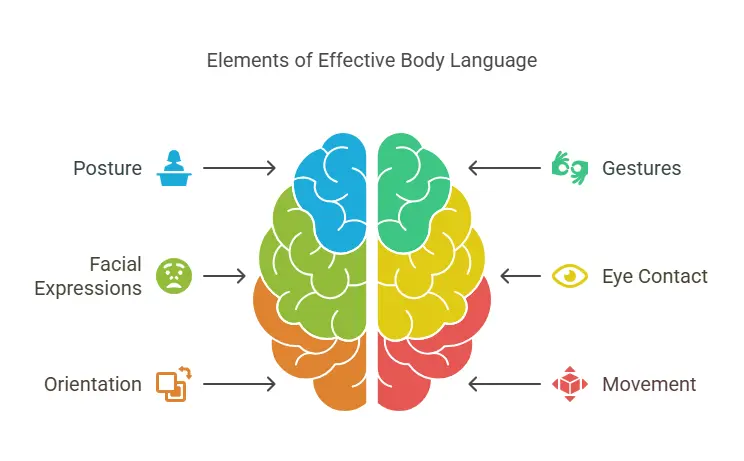Table of Contents
Good communication in the workplace goes beyond words to include your manner of saying things. Your words are perceived in significant part by body language, which affects team dynamics as well as leadership efficacy. Mastery of your body language will enable you to establish closer relationships, enhance your professional reputation, and even prevent misinterpretation. Whether you’re in a meeting, presenting, or just working with coworkers, your body can convey many subtleties. Indeed, some studies show that up to 93% of communication is nonverbal, so be aware of the messages you send with your body language. In this blog post, let’s explore the power of body language in workplace communication.
Begin Your Personality Transformation- Enroll Today!
The Role of Body Language in Communication
Body language either enhances or diminishes spoken communication. It addresses your posture, gestures, facial emotions, eye contact, and even your orientation, movement, or position. These nonverbal cues convey attitudes, emotions, and responses, so they either complement or contradict the spoken language.
During a conversation, for example, crossing your arms could indicate defensiveness or discomfort even if your comments come out as honest. Conversely, maintaining proper posture and making eye contact will demonstrate confidence and respect. Good body language encourages a cooperative workplace, helps to reduce conflict, and builds trust.
Key Elements of Body Language in the Workplace
1. Eye Contact
Among the strongest nonverbal means of communication is eye contact. It says you are honest, polite, and attentive. Good eye contact builds connection and trust with your colleagues whether you are speaking or listening.
2. Posture
Your posture speaks much about your confidence and curiosity. While slouching makes you seem lazy or bored, standing or sitting straight communicates professionalism and concentration.
3. Facial Expressions
Facial expressions are consequently rather crucial in the communication of your reactions and emotions since they transmit feelings. A grin could show warmth and openness; a frown could show confusion or anxiety. Consider your facial expressions, particularly in delicate situations.
4. Gestures
Points are emphasized and interest shown by gestures involving hand movement and nodding. Improper or overly strong motions can be distracting. Use them to stress words; avoid exaggeration.
5. Space and Proximity
Speaking with someone will reveal something about your comfort level or relationship based on how close you are to them. While standing too far away can indicate apathy, standing too close can be invasive. Positive interactions depend on respect of people’s space.
Boost Your Skills & Kickstart Your Career!
Employability and Personality Development Course by Entri App: Enhance your communication, confidence, and job-ready skills to excel in your career.
Join Now!Common Body Language Mistakes to Avoid at Work
1. Crossing Arms
Even though it is a relaxed stance, crossed arms will generally be a representation of defensiveness, resistance, or discomfort. It can make you appear closed-off at the workplace despite your effort to relax.
2. Fidgeting
Fidgety hands, tapping your foot, or continual gazing about could all point to anxiousness, annoyance, or lack of concentration. Though that’s not your goal, it can cause others to become disinterested or anxious and reflect your own.
3. Bad Eye Contact
Steer clear of eye contact to project dishonesty, lack confidence, or disengagement. Still, aim for a balanced approach; looking too much can seem frightening.
4. Slouching
Slouching in your chair or adopting a laid-back attitude in meetings could convey sloth, apathy, or lack of professionalism. You should keep your posture that corresponds with your degree of participation.
5. Over-Gesticulating
Speaking with too many hand motions could become distracting and dilutes your message. It can also give you an undulating or too emotional impression. Emphasize important ideas with modest gestures.
How to Read and Interpret Colleagues’ Body Language
Pay attention to the body language of your co-workers so that you can pick up on their emotions and reactions, and get a better feel for the conversation. Below given are some tips for reading body language:
- Look for clusters of cues: A single gesture or expression is not enough to be certain of what it signifies, so consider the larger picture. For example, a furrowed brow with crossed arms and evading eye contact could indicate frustration.
- Watch comfort levels: If a coworker is standing too far or constantly changing position, they are probably uncomfortable or defensive in the interaction.
- Observe behavior changes: Pay attention to any changes in your coworker’s body stance. If an individual becomes stiffer suddenly, ceases to make eye contact, or starts fidgeting, they are upset or anxious.
Begin your personality transformation—Enroll now!
Final Thoughts
A very effective tool for improving workplace communication is body language. Knowing your own nonverbal signals and learning to understand those of others will help you to better negotiate professional circumstances, enhance your interactions, and strengthen your connections. Your body language will affect how people see you whether you are presenting, attending a meeting, or just chatting casually. Developing body language calls both constant attention and practice. Awareness of your nonverbal signals will help you to improve your leadership and communication skills.
Boost Your Skills & Kickstart Your Career!
Employability and Personality Development Course by Entri App: Enhance your communication, confidence, and job-ready skills to excel in your career.
Join Now!Frequently Asked Questions
What if my body language is misinterpreted?
Misunderstandings can happen. If you notice confusion or a negative reaction, clarify your intentions verbally and adjust your body language to match your words. For example, uncross your arms if you’re being perceived as defensive.
Are there cultural differences in body language?
Yes, body language can vary across cultures. For example, eye contact may be seen as a sign of respect in some cultures, while in others, it may be considered rude. Be mindful of cultural differences when interacting with international colleagues or clients.
How can I improve my body language at work?
Improving body language starts with self-awareness. Practice good posture, make appropriate eye contact, and use natural gestures. Record yourself in meetings to observe your body language or ask for feedback from a trusted colleague.
Can body language impact my leadership effectiveness?
Yes! As a leader, your body language influences how others perceive you. Confident posture, open gestures, and strong eye contact can help you appear approachable and authoritative, building trust and respect among your team.
How can I tell if someone is uncomfortable during a conversation?
Signs of discomfort include avoiding eye contact, fidgeting, crossing arms, or leaning away from you. These body language cues can suggest the person feels uneasy or is not fully engaged.













